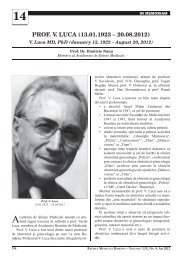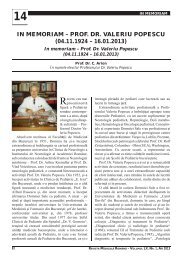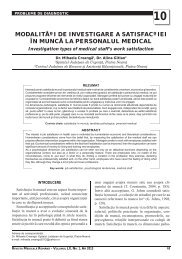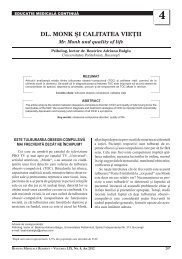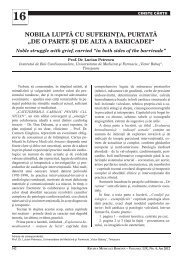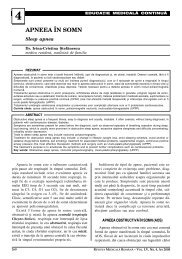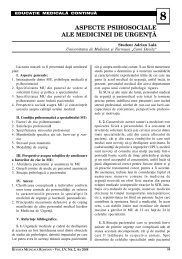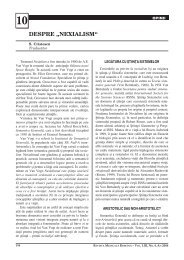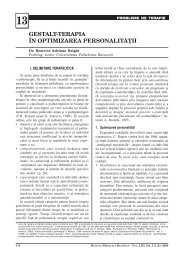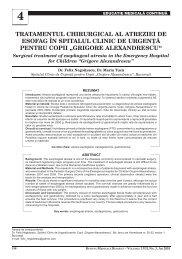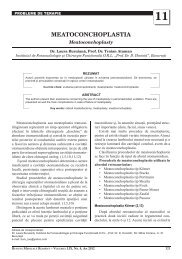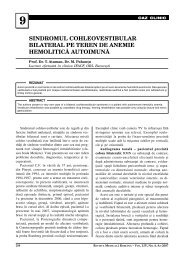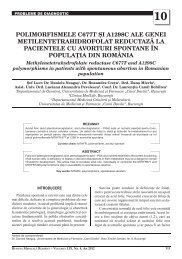Create successful ePaper yourself
Turn your PDF publications into a flip-book with our unique Google optimized e-Paper software.
150<br />
<st<strong>ro</strong>ng>3.</st<strong>ro</strong>ng><br />
ence, fasting plasma glucose and HbA1c. As<br />
we expected, the body and trunk adipose tissue<br />
percents were higher in the g<strong>ro</strong>up 2, but<br />
without statistical signifi cance.<br />
Fasting insulin and HOMA IR were positive-<br />
ly correlated with waist circumference, body<br />
mass index and body fat percent.<br />
Study on the paraoxonases: repercussions<br />
for ch<strong>ro</strong>nic metabolic diseases and<br />
athe<strong>ro</strong>scle<strong>ro</strong>sis risk<br />
Daniela Lixandru 1,2 , Irina Stoian 1 ,<br />
Bogdana Virgolici 1 , E.V. Bacanu 3 , Maria Mohora 1 ,<br />
Constanti n Ionescu-Tirgoviste 3<br />
1 Department of Biochemistry,<br />
University of Medicine and Pharmacy “Ca<strong>ro</strong>l Davila”,<br />
Bucharest, Romania<br />
2 Insti tute of Biochemistry of the Romanian Academy,<br />
Bucharest, Romania<br />
3“ N Paulescu” Nati onal Insti tute of Diabetes, Nutriti on<br />
and Metabolic Disease, Bucharest, Romania<br />
One of the st<strong>ro</strong>ngest risk factors for co<strong>ro</strong>nary<br />
heart disease (CHD) has p<strong>ro</strong>ved to be low plasma<br />
high-density lipop<strong>ro</strong>tein (HDL) concentration.<br />
HDL is subject to substantial compositional variations<br />
under both normal and pathological metabolic<br />
conditions.<br />
The antioxidant activity of HDL is largely due<br />
to the paraoxonase1 (PON1) located on it. Studies<br />
in the last two decades have demonstrated PON1<br />
ability to p<strong>ro</strong>tect against athe<strong>ro</strong>scle<strong>ro</strong>sis by hyd<strong>ro</strong>lyzing<br />
specifi c derivatives of oxidized choleste<strong>ro</strong>l<br />
and/or phospholipids in oxidized low-density lipop<strong>ro</strong>tein<br />
and in athe<strong>ro</strong>scle<strong>ro</strong>tic lesions. Signifi cant<br />
advances have been made in understanding the basic<br />
biochemical function of PON1 and the discov-<br />
REVISTA MEDICALÅ ROMÂNÅ – VOLUMUL LIX, NR. 2, An 2012<br />
Sex HOMA-IR<br />
G<strong>ro</strong>ups Women Men p<br />
G<strong>ro</strong>up 1<br />
HOMA-IR4<br />
p<br />
Age (years) 56.79±7.33 57.03±8.21 ns 58.51±5.92 56.47±7.30 ns<br />
Weight (kg) 87.07±1<st<strong>ro</strong>ng>3.</st<strong>ro</strong>ng>16 96.58±11.12 ** 86.83±12.89 89.62±11.38 ns<br />
BMI (kg/m2 ) 34.15±5.27 32.49 ±<st<strong>ro</strong>ng>3.</st<strong>ro</strong>ng>60 0.08 32.08±<st<strong>ro</strong>ng>3.</st<strong>ro</strong>ng>73 32.99±<st<strong>ro</strong>ng>3.</st<strong>ro</strong>ng>90 ns<br />
WC (cm) 108.54±11.24 109.90±7.62 ns 104.27±9.50 108.47±9.76 ns<br />
FPG (mg/dl) 152.63±41.87 130.79±37.51 0.02 130.65±3<st<strong>ro</strong>ng>3.</st<strong>ro</strong>ng>99 157.70±44.16 *<br />
HbA1c (%) 6.85±1.30 6.81±1.10 ns 6.46±1.04 6.97±1.37 0.09<br />
Fasti ng insulin (µU/ml) 15.59 ±8.32 12.40 ±5.16 * 8.11±2.84 18.24±6.47 **<br />
HOMA-IR<br />
index<br />
5.90±<st<strong>ro</strong>ng>3.</st<strong>ro</strong>ng>44 4.15±2.12 * 2.62±0.96 6.97±2.91 **<br />
Body adipose ti ssue<br />
percent (%)<br />
4<st<strong>ro</strong>ng>3.</st<strong>ro</strong>ng>48±4.64 29.62±5.71 ** 36.84±6.85 39.24±7.79 ns<br />
Trunk adipose ti ssue<br />
percent (%)<br />
40.48±5.84 3<st<strong>ro</strong>ng>3.</st<strong>ro</strong>ng>71±4.45 ** 36.08±5.36 38.56±6.96 ns<br />
ery of possible modulators of its activity. Recently<br />
two other members of the PON gene family, namely,<br />
PON2 and PON3 have also been reported to<br />
possess antioxidant p<strong>ro</strong>perties and may exhibit antiathe<strong>ro</strong>scle<strong>ro</strong>tic<br />
capacities as well. By this time is<br />
well know that paraoxonases are enzymes with<br />
three (paraoxonase, arylesterase and lactonase) activities<br />
which are inversely related to cardiovascular<br />
disease.<br />
This study consists in the comparative analysis<br />
of the PONs activity and the relevance for athe<strong>ro</strong>scle<strong>ro</strong>tic<br />
p<strong>ro</strong>cess. Is also present the implication of<br />
envi<strong>ro</strong>nmental factors and oxidative stress as well<br />
as the pozitiv corelation between PONs levels and<br />
degrees of metabolic disorders associated with athe<strong>ro</strong>scle<strong>ro</strong>sis<br />
like obesity and diabetes mellitus.<br />
Acknowledgement. Dr. D.L. was supported by<br />
the postdoctoral p<strong>ro</strong>gram POSDRU/89/1.5/S/60746,<br />
f<strong>ro</strong>m Eu<strong>ro</strong>pean Social Fund.<br />
Rolul stresului oxidati v în boala renală<br />
diabeti că<br />
Elena Violeta Băcanu 1 , Daniela Lixandru ²,<br />
Irina Stoian 2 , Bogdana Vîrgolici 2 , Maria Mohora 2 ,<br />
Constanti n Ionescu-Tîrgovişte 1<br />
1 Insti tutul Naţional de Diabet, Nutriţie şi Boli<br />
Metabolice ,,N.C. Paulescu“, Bucureşti , România<br />
²Universitatea de Medicină şi Farmacie ,,Ca<strong>ro</strong>l Davila“,<br />
Catedra de Biochimie, Bucureşti , România<br />
Int<strong>ro</strong>ducere<br />
Boala renală diabetică (BRD), defi nită ca o boală<br />
glomerulară p<strong>ro</strong>gresivă, de natură predominant infl<br />
a matorie, evoluează negativ în mediul diabetic.<br />
Scopul prezentului studiu a fost evaluarea statusului<br />
oxidativ/antioxidativ şi corelarea acestuia cu mar-



